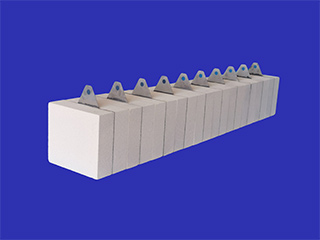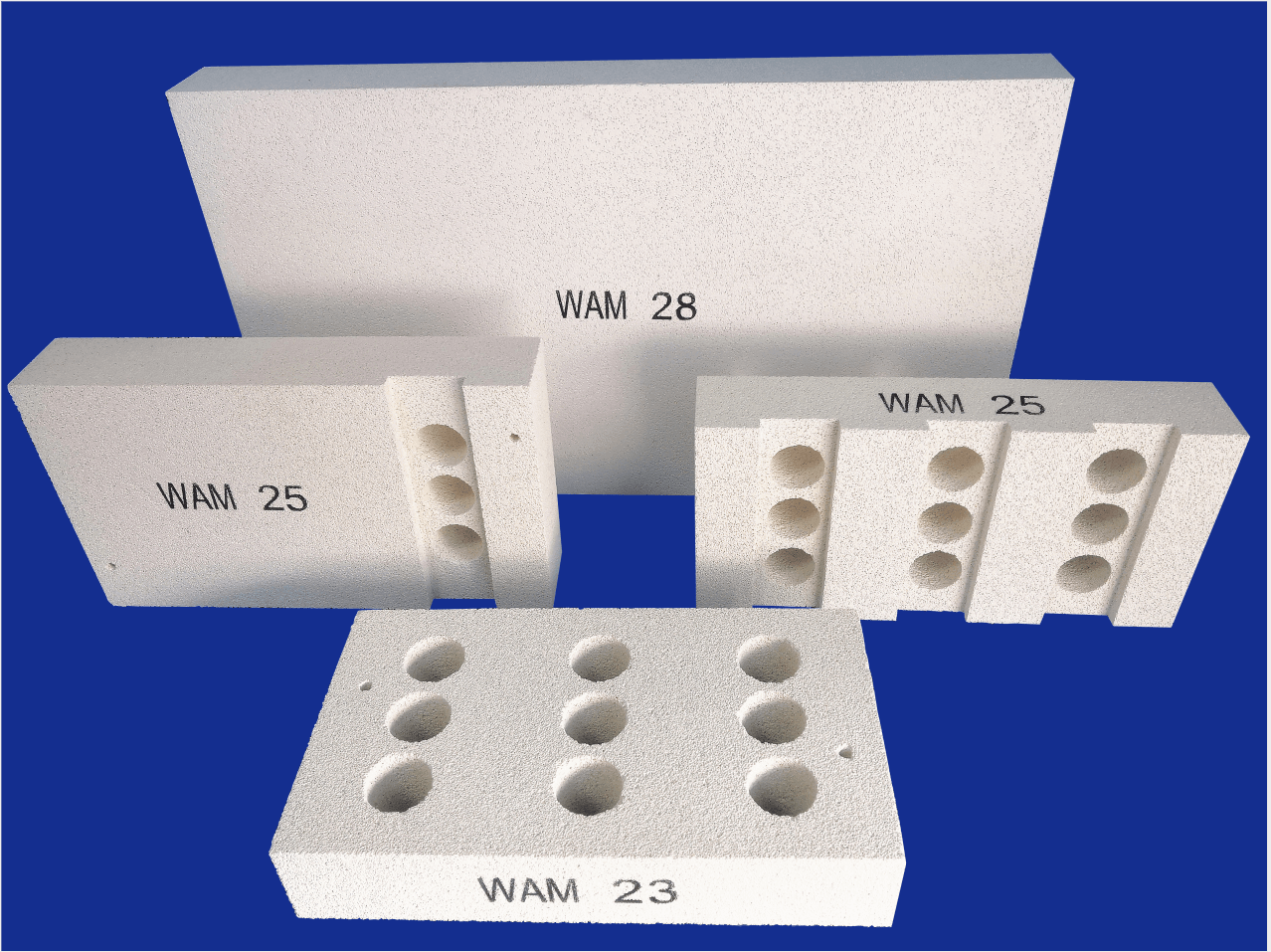The Best Solution For Energy Saving And Reducing CO2 Emission
The Best Solution For Energy Saving And Reducing CO2 Emission
 Tel: +86-532-85717690/85717352/85832089
Tel: +86-532-85717690/85717352/85832089 E-mail: wam@wamcn.net
E-mail: wam@wamcn.net
The invention of insualting bricks is to be understood that variations, changes and modifications are contemplated within the scope of the invention as defined by the following claims.

1. A moldable heat hardenable matrix mixture adapted for making light weight refractory insulating brick having a density of 48-53 lbs.cu. ft. and substantial volumetric stability up to 26000 F. consisting essentially of finely divided bonding clay, kyanite and pyrophyllite in approximately the dry weight proportions of about 16 parts each of kyanite and pyrophyllite.
2. A refractory insulating brick having a density not substantially exceeding 55 lbs.cu. ft. and substantial volumetric stability up to 26000 F., having a matrix consisting essentially of the fired reaction product of finely divided clay bonding agent, kyanite and pyrophyllite in approximate dry weight proportions of 40-45 parts of clay and 16-20 parts kyanite and pyrophyllite in the dry weight proportions of .5-11.
3. A refractory insulating brick having a density of approximately 50 lbs.cu. ft. and having a PCE of at least cone 30 having a matrix consisting essentially of the burned reaction product of approximately two parts finely grained kaolin and 1 parts each of kyanite and pyrophyllite, said brick having a reheat linear shrinkage of not to exceed about 1% when fired for several hours at a temperature of 26000 F.
4. A refractory insulating brick as defined in claim 1, having a transverse strength of at least 115 lbs.sq. in. and a crushing strength of at least 6o 175 lbs.sq. in.
5. A light weight refractory insulating brick consisting essentialy of the oxidized and fired reaction product of finely divided refractory bonding clay, finely divided kyanite, finely divid.-s ed pyrophyllite, water, 10-30% dry weight of grog and 15-25% finely divided organic burnout material, the reactive components of said batch being proportioned in the ratio of about 25-60% dry weight of the clay to 5-20% each of the kyanite o and pyrophyllite.
6. In the manufacture of refractory brick the steps comprising, forming a plastic brick molding batch comprising 5-20% dry weight of finely divided raw kyanite, 5-20% finely divided pyrophyllite, 30-60% dry weight of finely divided refractory bonding clay and water, incorporating in said batch 15-25% dry weight of sawdust and 10-30% of grog, molding to brick form and firing to burn out the sawdust.
7. In the manufacture of light weight insulating brick the steps comprising, forming a plastic brick molding batch comprising 25-60% dry weight of finely divided refractory bonding clay, 5-20% finely divided kyanite, 5-20% finely divided pyrophyllite, water, 10-30% grog and 15-25% organic burn out material, and proportioning the kyanite and pyrophyllite in the dry weight proportions of .5-11.
8. A process of manufacturing light weight refractory brick which comprises, forming a plastic mixture including 30-60% finely divided kaolin, 5-20% each of finely divided kyanite and pyrophyllite, 15-25% of finely divided organic burn out material, 10-30% of grog, and water, filling a mold with the plastic mixture, drying the molding shape, and firing the dry brick to burn out the combustible material and develop a ceramic bond.
9. In the manufacture of porous insulating brick the steps comprising, forming a plastic batch containing water and a uniformly distributed mixture of 10-30% by weight of finely ground grog, 25-60% finely divided refractory bonding clay, 15-25% finely divided organic burn out material and 5-20% each of finely divided raw kyanite and pyrophyllite, charging a mold with said batch, drying the molded shape and heating it in an oxidizing atmosphere to burn out the organic content and to a firing temperature of approximately 24500 F to 26000 F. to develop dimensional stability.
10. A process of making refractory insulating brick which comprises, forming a molding batch containing about one part water and two parts dry solids comprising approximately 40% finely divided kaolin, 10% each of finely divided kyanite and pyrophyllite, 20% of grog and 20% of saw dust, molding said batch, drying the moldel product, and firing it in an oxidizing atmosphere between 24500 F. and 2600 F.

About us
Qingdao Western Coast Advanced Materials Co., Ltd. (WAM) established in 2007 and located in the beautiful coastal city – Qingdao, is a leading manufacturer of wide range of mullite insulating bricks worldwide. WAM insulating products are widely applied in middle and high temperature furnaces in the field of Metallurgy, Aluminum, Petrochemical, Ceramics, Power and Glass industry, etc. If you are looking for a reliable merchandise of insulating bricks, please contact us now!